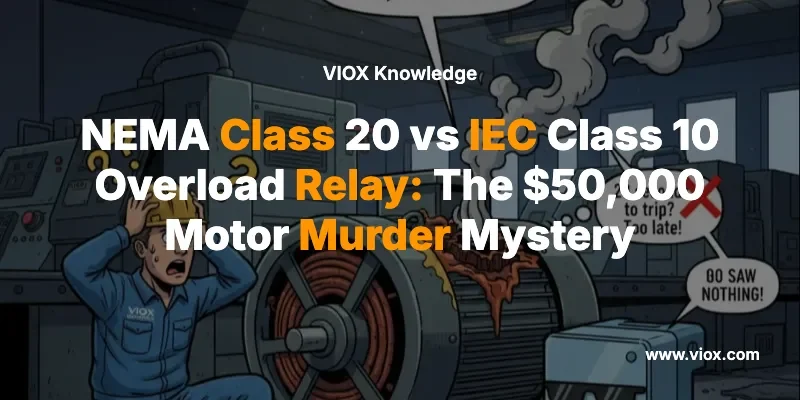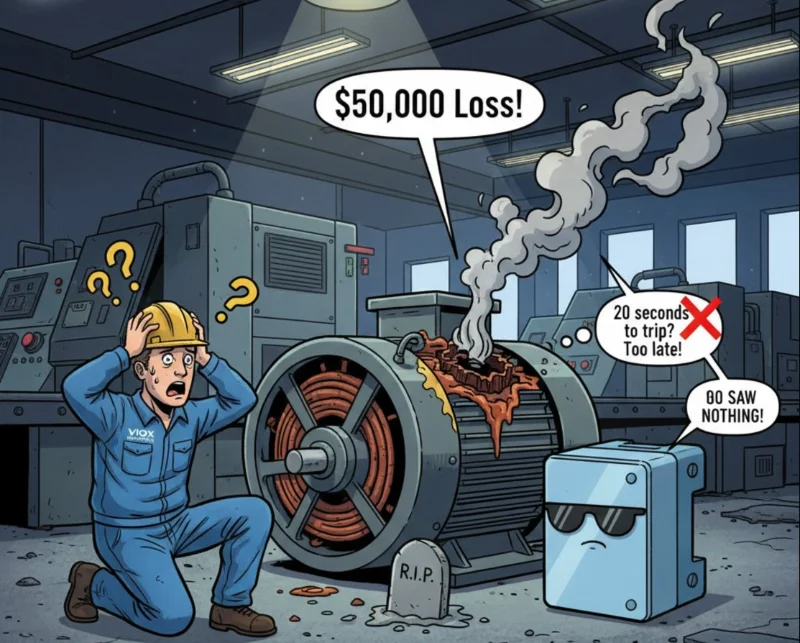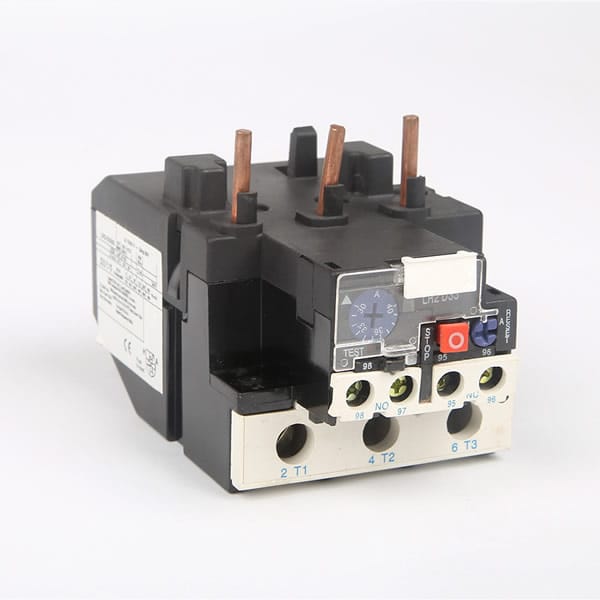Six months later, your motor screams to a halt. The 200 HP unit that drove your main production line is cooked – windings blackened, insulation crumbled, the stator housing still radiating heat like an industrial crematorium. Your Class 20 overload relay watched the murder unfold. Never lifted a finger.
All because six months ago, you chose the relay class that gave you the most time instead of the one that would save your motor.
How does a $200 component decision turn into a $50,000+ disaster? The answer reveals why most engineers unknowingly specify motor protection that creates failure conditions instead of preventing them.
Why Your “Conservative” Class 20 Choice Destroys Motors Faster Than Class 10
The Cold Start Killer exploits thermal physics that most engineers never consider. After a weekend shutdown, your motor windings are cold – meaning they can absorb 10-20% more current than during normal hot operation before reaching the same temperature. That 8-second start time you measured during commissioning? Add 1-3 seconds for Monday morning reality. Here’s where the weapon operates: Class 20 gives your motor up to 20 seconds to reach thermal destruction. Class 10 trips in 4-10 seconds. Engineers love to round down on contactors and round up on pizza toppings. One works better than the other.
Motor insulation follows brutal math: every 10°C above limits halves insulation life. At 600% starting current, that “conservative” 20-second window becomes a death sentence. The I2t relationship doesn’t care about your engineering degree. Damage ∝ I2 × t. Period. At 600% current (36× normal heating), you have approximately 12 seconds before thermal damage occurs in most industrial motors – well within Class 20’s trip window but safely protected by Class 10’s faster response.
When you open that failed motor, the evidence tells the story: windings that look like they’ve been through industrial trauma, insulation compromised, copper conductors stressed beyond limits. The Class 20 relay sat there for 12+ seconds watching the temperature climb past safe limits, thinking ‘plenty of time left.’ Your motor’s thermal budget ran out first.
The Thermal Budget: Why Motors Have Less Time Than You Think
Your high school physics teacher never mentioned The Thermal Budget, but it’s the most important equation in motor protection. Think of it like a checking account: every degree above the motor’s temperature limit represents a withdrawal from a finite account. Class 10 protection monitors the balance and stops withdrawals before overdraft. Class 20 provides unlimited spending for up to 20 seconds, then acts surprised when the account reaches zero.
The current-time relationship defies linear intuition: at 200% current, you have minutes before thermal damage. At 400% current, maybe 30 seconds. At 600% starting current, approximately 12 seconds remains. The I2t protection model governs regardless of engineering intuition: when ∫(I2 – 1)dt reaches the thermal limit, insulation failure begins. Most engineers see “20 seconds” and think “conservative.” Motors see 600% current and initiate emergency thermal protocols.
The 10°C Tax steals your thermal budget when you’re not looking. Every 10°C above 40°C ambient temperature reduces both motor capacity and relay sensitivity. That control panel hitting 60°C by mid-afternoon? Hot enough to make you pull your hand back. Hot enough to rob your 25A contactor of 7 amps of capacity. The protection gap widens precisely when thermal stress peaks – The 10°C Tax collected in motor windings.
5-Step Method to Select Overload Relay Class That Prevents Motor Failures
Step 1: Calculate Your Motor’s Actual Thermal Budget
Start with authentic thermal limits – not nameplate optimism. For typical NEMA Design B motors with Class F insulation, thermal damage occurs at approximately 12-15 seconds under 600% locked-rotor current. But the reality most engineers miss: cold windings absorb 10-20% more current before reaching temperature limits. Your measured 8-second start time becomes 9-11 seconds during Monday morning restart.
Pro-Tip #1: The Cold Start Multiplier: Cold motor windings absorb 10-20% more current during startup than hot motors. That 8-second start time you measured during commissioning? Add 1-3 seconds for Monday morning reality. If calculations show 10 seconds to thermal damage, Class 20’s 20-second window isn’t conservative – it’s catastrophic.
Account for actual conditions: high-inertia loads extend starting time, low voltage extends starting time, cold ambient temperature extends starting time. Apply 20% safety margin for real-world variables. If your motor needs 10 seconds for safe acceleration, and thermal damage occurs at 12 seconds, Class 10’s 4-10 second window provides protection. Class 20’s 6-20 second window risks destruction.
Step 2: Map Trip Times Against Thermal Damage Curves
Coordination analysis remains straightforward: overlay motor thermal damage curves with relay trip characteristics. For typical 200 HP motors (240-250A FLA for 460V systems) with 12-second thermal damage time at 600% current, the protection requirements become clear. Class 10 provides 4-10 seconds to trip – consistently before thermal damage. Class 20 allows 6-20 seconds – sometimes protective, sometimes destructive. “Sometimes” isn’t a protection strategy.
Pro-Tip #2: The 600% Rule: Always verify motor locked rotor time capability against relay class limits plus 10% margin. If motors survive 12 seconds at 600% current, Class 10 provides 4-10 seconds. Class 20 provides 6-20 seconds. Select the class tripping before thermal damage – not the one providing maximum time.
But here’s the counter-intuitive truth that separates good engineers from great ones: faster protection often means fewer nuisance trips, not more. When protection operates quickly and predictably, you can optimize settings closer to actual operating conditions. Class 20’s wide window forces conservative settings to avoid occasional late trips that kill motors. Class 10’s consistent, faster operation enables optimization for both protection and operational efficiency.
Step 3: Factor in Hidden Protection Requirements
Single-phase detection represents the most significant hidden difference between NEMA and IEC protection philosophies. IEC 60947-4-1:2020 mandates Class 10 relays detect and respond to single-phase conditions within 10 minutes at 130% current. NEMA ICS 2-223:2023 doesn’t require single-phase detection for Class 20 relays. In pump, chiller, and fan applications where single-phasing destroys motors in under 3 minutes, that “conservative” Class 20 choice creates failure modes that Class 10 catches automatically.
Pro-Tip #3: The Single-Phase Blind Spot: NEMA Class 20 relays don’t require single-phase detection. IEC Class 10 does. In pump and chiller applications, single-phasing can destroy motors in under 3 minutes. That “conservative” Class 20 choice creates failure modes that Class 10 would catch automatically.
Environmental derating reduces protection capability when most needed. The 10°C Tax applies to both motors and relays: approximately every 10°C above 40°C ambient reduces relay sensitivity by 2-6% (varies by manufacturer). Control panels reaching 60°C during summer afternoons? Your 25A Class 20 relay operates closer to 21-23A effective capacity, while motors still demand 24A at full load. The protection gap widens when thermal stress peaks.
Quality check selections against actual failure modes in your application. High-inertia loads need faster protection, not slower. Frequent starting cycles need predictable trip times, not wide windows. Critical applications need the advanced features electronic IEC relays provide: ground fault detection, phase imbalance protection, thermal modeling accounting for starting history. Of course it failed on a Friday at 4:45 PM – that’s when the thermal budget finally depleted after a week of 10°C Tax withdrawals.
Understanding Protection Speed Prevents Motor Murder
Understanding The Cold Start Killer prevents motor murder. Mapping The Thermal Budget prevents insulation bankruptcy. Avoiding The False Security of Slow prevents catastrophic failures. The next overload relay you specify will either protect your motor or provide false security while it destroys itself. The difference isn’t the price of the relay – it’s understanding that faster protection often means safer operation.
The Class 10 vs Class 20 decision determines whether you get a text message to investigate a trip or a 2 AM emergency call that production is down. Choose the class that trips before thermal damage occurs, not the one that gives you the most time to watch the destruction unfold. Your motor’s thermal budget is finite. Spend it wisely, or The Cold Start Killer will collect the debt with interest.
Pro-Tip #4: The Temperature Derating Trap: Approximately every 10°C above 40°C ambient robs your overload relay of 2-6% capacity (varies by manufacturer). That control panel hitting 60°C by afternoon? Your 25A Class 20 relay may operate closer to 21-23A effective capacity. But your motor is still drawing 24A. The math doesn’t work, and your motor is living on borrowed time.
Motor protection isn’t about picking the class with the longest time – it’s about understanding that your motor’s thermal budget runs out faster than you think, especially when The 10°C Tax and The Cold Start Killer work together. Class 10 protection watches your thermal budget and stops withdrawals before you overdraft. Class 20 gives you unlimited spending until the account is empty and the motor is dead. The choice that prevents the next $50,000 motor murder is the one that respects the thermal budget, not the one that ignores it.







